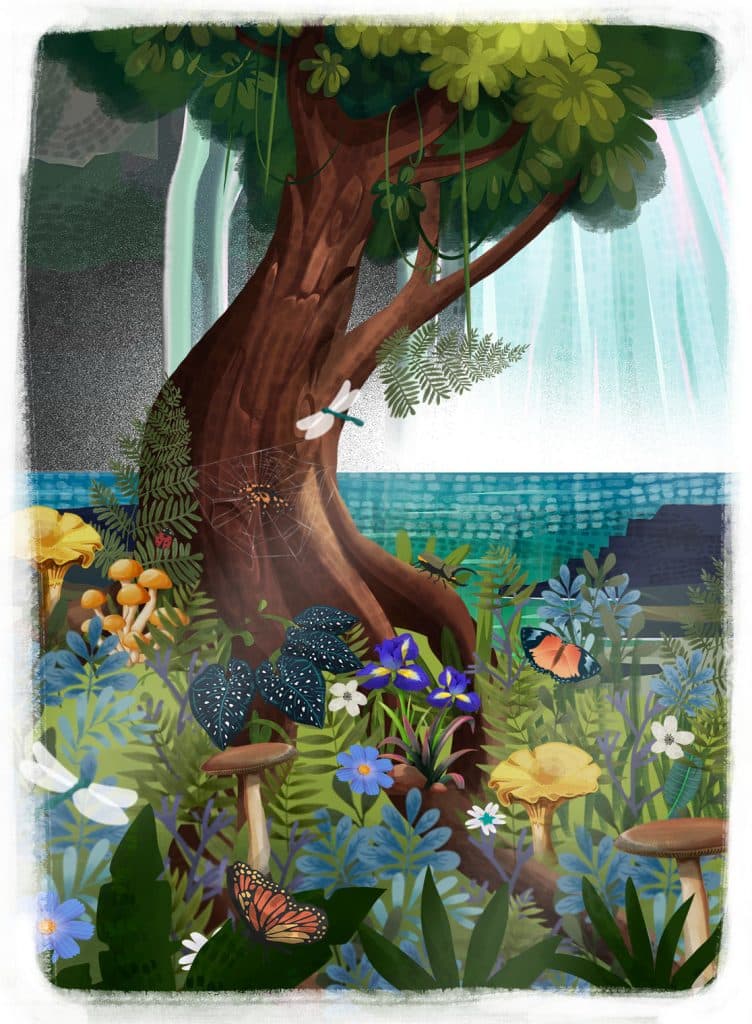Trees have always felt like the upward raised hands of the Earth seeking rain, wind, and sunlight from the skies, while keeping myriad living and non-living things safe under their protective canopy. They never cease to fill me with awe and inspiration—their architecture, their defiance of gravity, their ability to soar above even as their roots dig deep into the soil. As an ecologist who has spent considerable time studying trees, I have had the joyful experience of hugging at least a thousand of them in the course of taking valuable diameter measurements!
Conservation of Nature usually finds its way into the hearts and minds of people through furry and huggable or majestic and awe-inspiring animals. This leaves tiny but spectacular orchids, serpentine climbers, creepy crawly insects, scaly snakes and frogs and a whole host of life forms unnoticed. Animals are given priority, while plants seem like they are every where and not particularly under threat of any loss. Up until we spend more time exploring and improving our understanding about the ecology or interdependencies that form the web of life.
Then we realise that a tree in the forest is more than just the flowers, fruits, and the leaves it produces. The bark has a host of mosses, ferns, frogs, crabs, insects, and orchids living on it. The canopy is home to a diversity of pollinators, primates, and other mammals. What happens in the deep roots and their capillaries that weave through the forest forming a vast network below ground is even less understood. A tree therefore becomes an entire habitat and even an ecosystem in the forest. In conserving a tree, one is protecting a web of relationships and interdependencies that are also threatened when that tree species is driven to extinction.
In the introduction to his book Against Extinction, Prof. Bill Adams writes about three timescales that conservation practitioners are engaged with—geological time which extends across millennia, a lifetime where one aspires to see change within a few decades, and the present, where every problem has to be addressed now or it will mean certain doom. Keeping these timescales in perspective is very important when one sets out to protect endangered species and to prevent their extinction.

The International Union for the Conservation of Nature (IUCN) maintains a Red List which is a comprehensive list of all living things and their conservation status. The information on populations, distributions, and the threats they face becomes invaluable when decisions on protection and preservation have to be taken. The Red Listing process assesses every species’ risk of extinction and places them under one of the nine stipulated categories: Data Deficient, Least Concern, Near Threatened, Vulnerable, Endangered, Critically Endangered, Extinct in the Wild, Extinct, and Not Evaluated. The assessments are based on information available about a species’ population and its range or distribution. These criteria are now globally accepted and widely used for conservation planning.
Through the articles in this special edition which are focussed on Endangered Trees, we want to draw attention to a world of plant conservation, which is replete with discovery, piracy, isolation, destruction, and lost relationships—all the makings of a conservation saga with trees as the protagonists.
As detailed in this series, once thought to be extinct in the wild, one species of the Faveiro trees of Brazil was rediscovered a hundred years ago and conservation plans are being implemented to ensure their long-term protection in the state of Minas Gerais. Another chance discovery of a cluster of Dipterocarpus bourdillonii trees in the Western Ghats of India spurred a large-scale survey for 11 endangered tree species in the Anamalai Hills, set against a backdrop of evolution, land use change, and global climate change. Moving on to the southern Western Ghats, where a single species from the genus Gluta is found (the only one in the Indian subcontinent), and although locally abundant in the forest, it faces a serious bottleneck in its life history, posing a threat to its long-term survival. But bottlenecks are many, when it comes to species in the wild, as in the case of the cycads from South Africa, where absence of beetle pollinators or their declines can have serious implications on populations in the wild. Human use poses a threat to the species as observed in the case of the Caryota palms, where the recreational or cultural use necessitates the removal of the flower—the reproductive part of the plant—even before it matures or has produced seed. Illegal wildlife trade is of concern to all wildlife, even plants, as seen in the article about the theft from the Gurukula Botanical Sanctuary in India and larger online trends. Finally, the fascinating history of the pivotal botanical text Hortus Malabaricus—with its detailed descriptions and meticulous illustrations of 780 plants of the Malabar region—is revealed.
Several species have been driven to extinction and are endangered owing to one or many of the reasons listed above. Will a species become extinct if we don’t act today or in our lifetime? Saving the Earth and protecting the planet by not letting anything die or go extinct has been the mainstay of conservation, which incidentally is only about 100 or so years old. From an evolutionary point of view extinctions give rise to newly adapted forms of life and keep the process of life moving ahead. Nothing stops in Nature. While saving species from dying seems like a short-term goal of conservation, there is a larger goal which I am afraid we are missing out on—literally losing sight of the woods for the trees. In the last few years in the mountains of South India, we have seen unprecedented weather patterns and a disruption of the rhythm of life. When a section of the grasslands and Shola forests of the Nilgiris collapsed in a landslide a few years ago, one started to wonder if our ecological footprint has now begun to challenge the very resilience of ancient landforms like the Western Ghats. What can we do now to rebuild the resilience of the Earth so it does not lose the capacity to bounce back after environmental disasters; this for me will be the long-term goal of conservation. We have to keep trying tree by tree, species by species, habitat by habitat to rebuild and restore that which is not completely lost.


